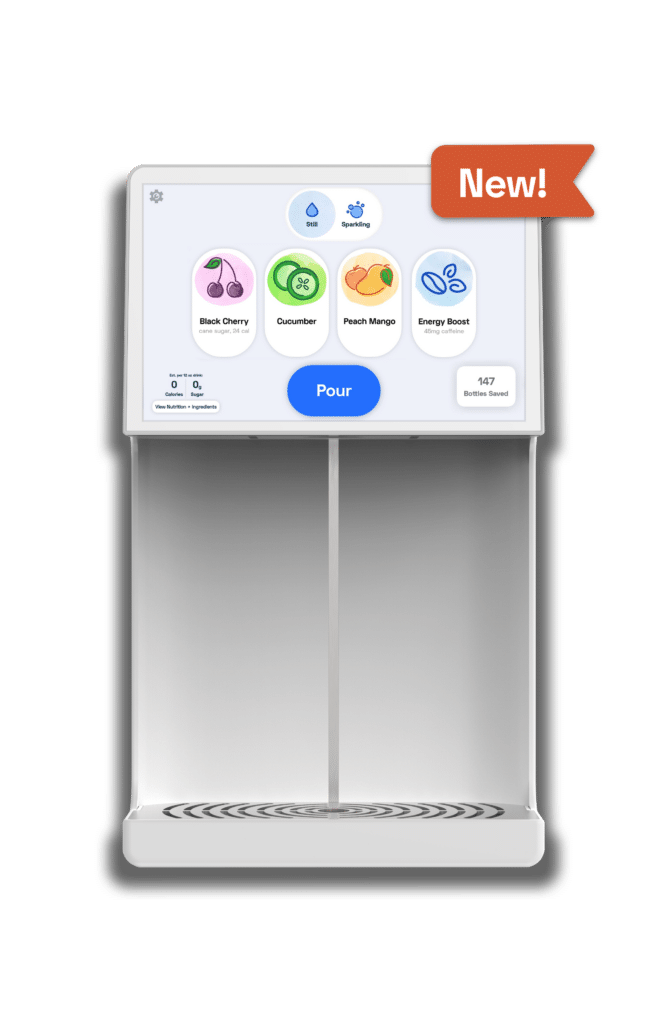January 27, 2025. Are we sick of talking about return to office yet? Five years after the pandemic changed how we work forever, we’re still seeing shifts in where and how people work, with flexibility and balance remaining top priorities.
The conversation about in-office work often focuses on weekly schedules: “How many days a week are you in?” But this oversimplifies how hybrid work actually plays out. Bevi’s latest office attendance data, based on anonymized usage of our Smart Water Coolers across industries and cities, reveals a broader, clearer picture of workplace trends in 2024.
For the record, I know the experience of balancing between working at home and working in the office firsthand. Most weeks, I’m in two days a week, sometimes more. On the days I’m in the office, I thrive on the energy of face-to-face meetings with my team, investors, and employees. Having space to catch up with the team over lunch is invaluable. Yet, on the days I work remotely, I can focus deeply, manage personal priorities—something I hold dear as a mother of three—and prepare for what’s ahead. This balance works because of the flexibility that allows work and life to sync more effectively.
The bigger picture is that flexible work leads to natural fluctuations in office attendance throughout the year. There are times when people come together more to collaborate and connect and times when they pull back to focus or recharge. Bevi’s data shows these patterns vary by city and industry, but the same principle applies: office attendance has clear seasonal rhythms.
The current return-to-office narrative, though, remains stuck in this-or-that, black-or-white thinking. In-office five days every week. Remote forever and always. Each of these polar opposite approaches—or even the sense that one of them will “win out” in the end—misses the deeper complexity of how people are balancing the different aspects of their jobs today.
Offices also need to evolve into spaces people want to spend time in. Gathering areas for informal connections, natural light, cafes, fitness centers, and green spaces are becoming the standard. The cubicle era is over, replaced by spaces designed for collaboration, creativity, and balance—places employees enjoy coming to, even if they’re coming in less often than before.
Hybrid work isn’t just about the number of days spent in the office; it’s about how the year looks as a whole and creating office spaces that make the most of the time people spend together. Bevi’s data shows employees are embracing this natural rhythm, and companies should do the same as they work to create true work-life balance.
Statement from Bevi CEO, Cathy Lewenberg
Trying to get employees back to the office?
Findings in this report
- Right on the money
- No industry is immune to RTO
- L.A. leads the way (still)
- Tuesday takeover
- Rise n’ grind
- Fast facts
1. Right on the money
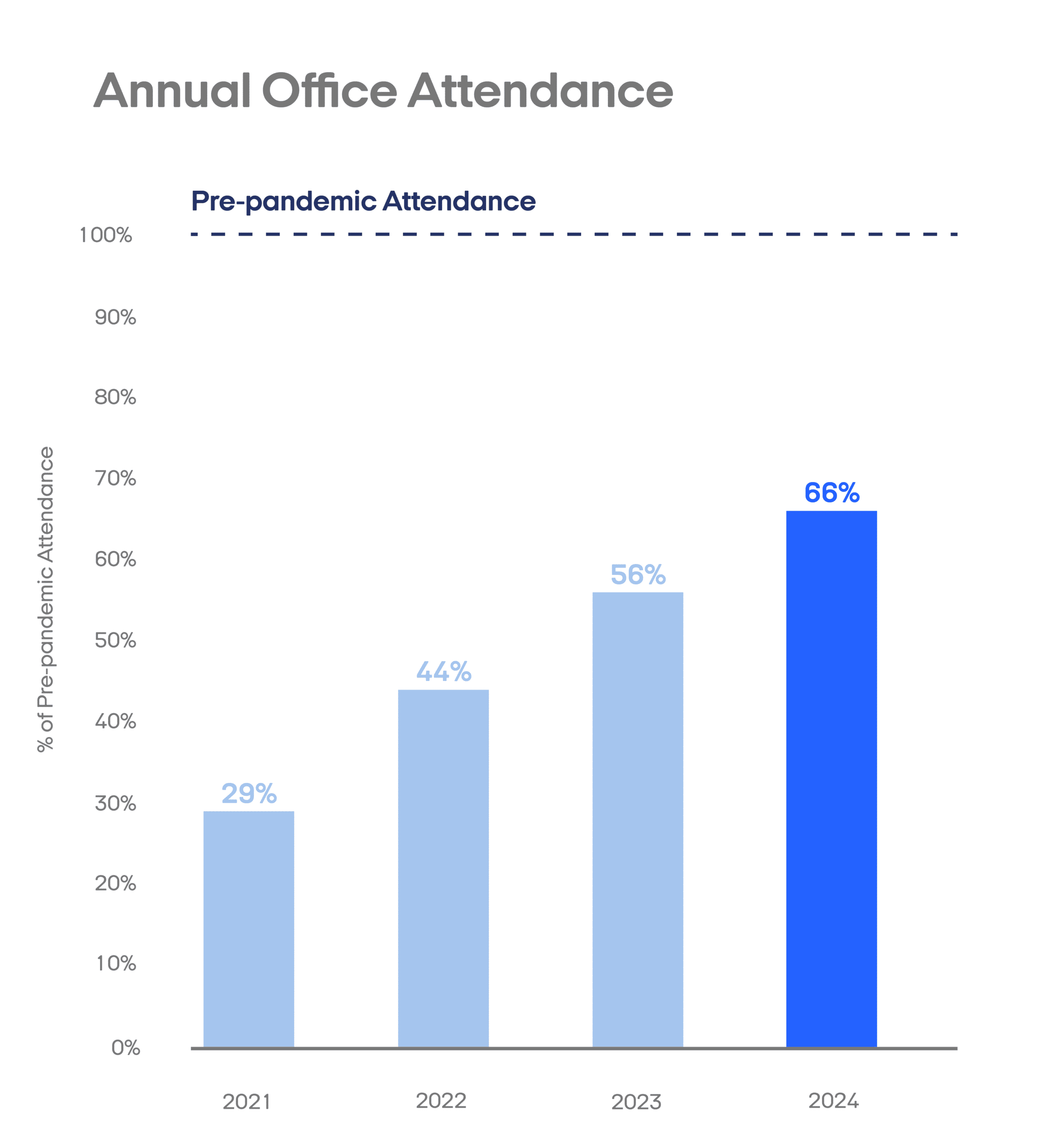
A reminder. Last January, based on trends we were seeing in aggregate, anonymized machine usage across thousands of U.S. locations, Bevi predicted that office attendance would reach 64% of its pre-pandemic level by the end of 2024. By the close of the year, we surpassed our initial prediction, hitting 66% office attendance—just shy of our stretch-case forecast of 69% that we made in September of last year.
Slow and steady. Office attendance in 2024, compared to pre-pandemic levels, was 10.3 percentage points higher than 2023; 2023 was itself 11.5 percentage points higher than 2022; and 2022 was 15 percentage points higher than 2021. While return-to-office mandates can feel to employees as if they come in waves, the bigger picture is that the year-over-year increases are relatively steady.
Enforcement challenges. Despite these mandates, adherence isn’t always consistent. Many employees find ways to skirt policies, whether by “coffee badging,” showing up briefly to appear compliant but finding the backdoor early, while others have informal, “hushed hybrid” arrangements with managers that allow them to come in less than official policies require. Some companies, like At&T, find themselves short on parking, desks, and patience from employees as they adjust to a new 5-day in-office policy, making adherence a challenge.
Where will we go this year? Across industries, a new wave of RTO mandates (in many cases, 4 or 5-day policies) in the past two months suggests that in 2025, we may see attendance climb even higher, potentially surpassing 75% of pre-pandemic levels.
2. No industry is immune to return to office trends
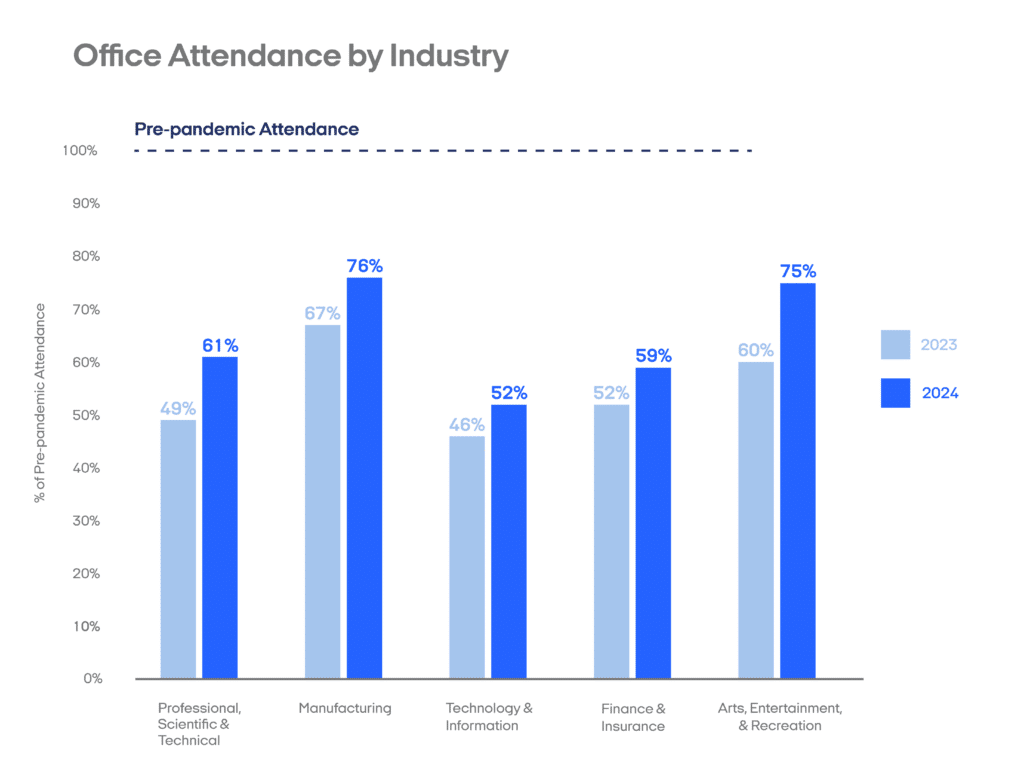
Everybody’s on the same page. While the year-over-year percentage point increase in office attendance since the onset of the Covid-19 pandemic is different for each industry, there is one clear similarity: every industry is spending more time in the office each year than the year before.
The office is open. There is no industry that is trending toward greater remote work; instead, all are steadily shifting toward more in-office attendance. Over the past two quarters alone, the percentage of companies requiring three or more days per week in the office rose from 19% to 28%, with nearly a third now mandating full-time, in-office work.
Get back here! Many organizations have introduced the old school, five-days-a-week return-to-office (RTO) policy. JPMorgan Chase plans to require full-time office attendance for its 300,000 employees starting in March 2025. On the West Coast, tech companies like Salesforce implemented stricter attendance policies in the Fall of 2024, and corporate Amazon employees are back in the office full-time to start 2025.
Back of the pack. The technology and information sector is trailing other industries, showing the smallest year-over-year growth in office attendance among the industries analyzed by Bevi—just a 7.1 percentage point increase from 2023 to 2024. This fits the narrative of tech companies, many of which have long embraced distributed work and seem more willing to sustain it than other sectors.
3. L.A. leads the way (still) for return to office
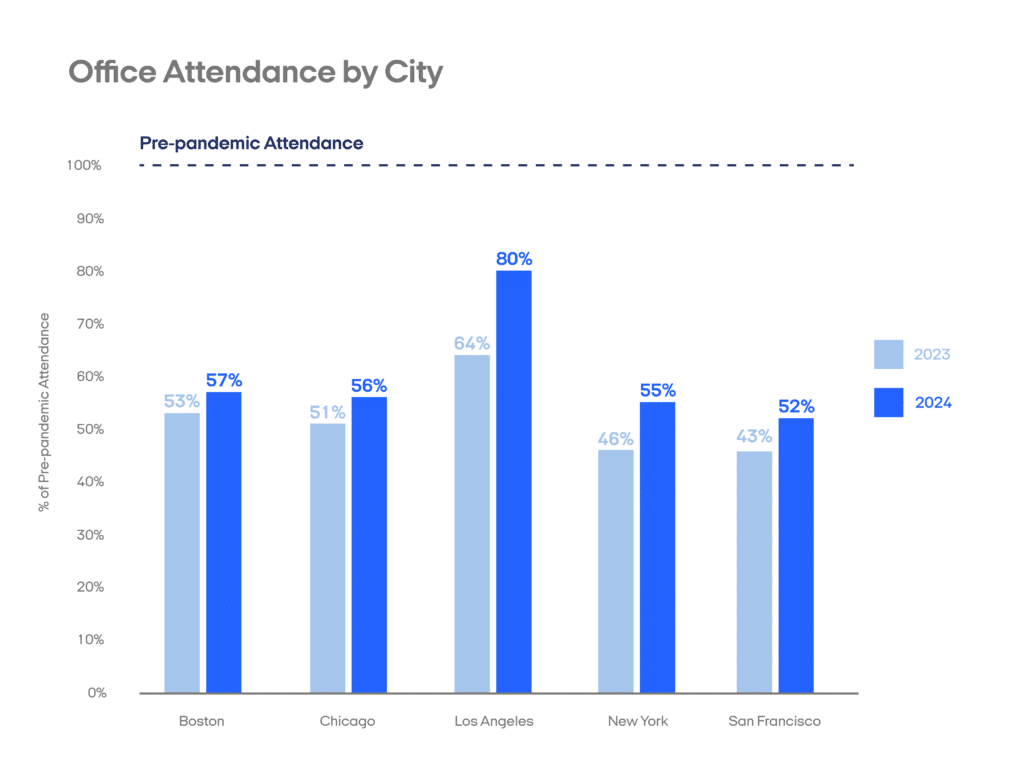
Cities are staying consistent. Last year, we released a return-to-office report halfway through the year, in which we noted Los Angeles (along with Boston) was leading the way in workers getting out of their homes and back in the office.
That metric looks even higher now. Reviewing the full year, Los Angeles office attendance soared to almost 80% of pre-pandemic levels. In a city with such a media-driven economy, the aftershocks of prolonged strikes and major industry shakeups seem to have brought people back together in offices, where brainstorming, strategizing, and adapting to disruptions like streaming service competition or the need to consolidate are happening face-to-face.
The lead is narrowing for Boston. While Boston still outpaces its peers in overall attendance levels, its growth in 2024—5.3 percentage points—ranks as the smallest amount of in-office growth for the U.S. cities we analyzed. Chicago saw a 6.6 percentage point increase; New York, 8 percentage points; San Francisco 9.9 percentage points; and Los Angeles, a substantial 14.4 percentage points.
Remote first. San Francisco sits at 51.9% of pre-pandemic office attendance—the lowest among the cities analyzed. Home to many of the technologies powering remote work, SF companies appear less invested in bringing employees back to the office. This trend is amplified by workforce challenges; although the city’s population grew slightly (0.15%) in 2023, it remains down 7.4% compared to April 2020, meaning there are far fewer people around to go into the office.
Great tasting water is no accident
4. Tuesday takeover
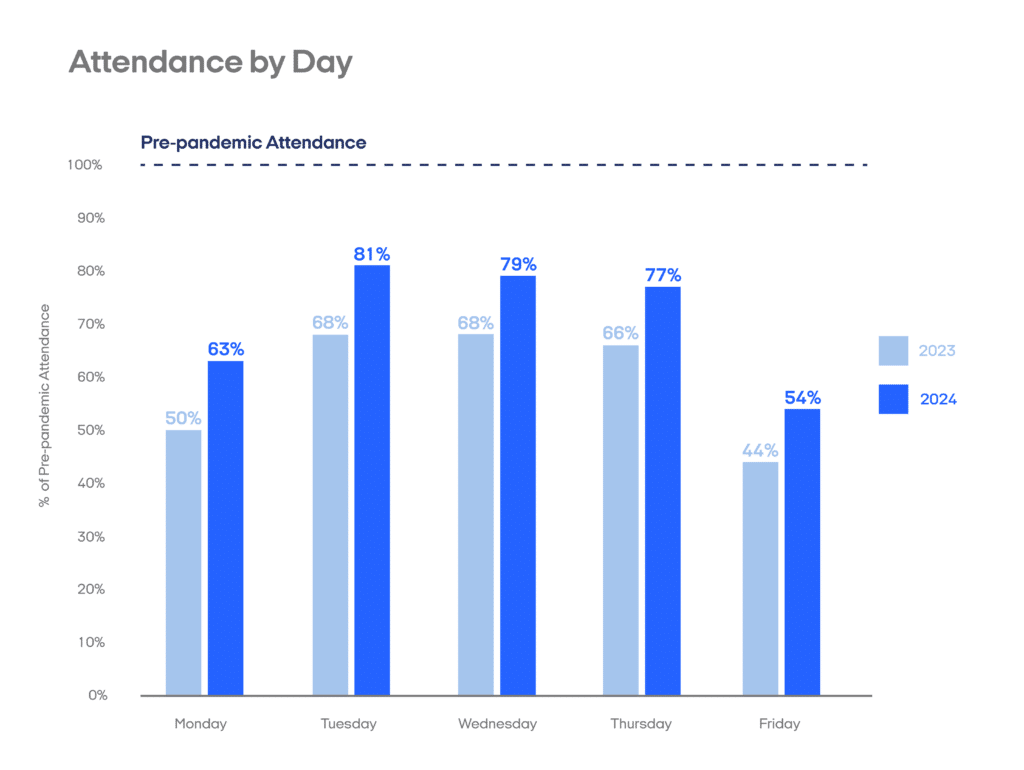
Tuesdays are pulling ahead. In 2024, Tuesdays emerged as the most popular day for employees to be in the office, staking a claim to the throne where Wednesday and Thursday looked to be putting up stiff competition throughout 2023 and the beginning of last year. As the midpoint between Monday’s catch-up and Wednesday’s midweek focused momentum, Tuesday has become the week’s anchor of in-person collaboration for many workplaces.
WFH Fridays are holding strong. Despite the jump in overall office attendance for each day of the week, Fridays remain the least attended day of the week still, and saw the smallest increase of 9.9 percentage points from 2023 to 2024. This pattern reflects employee preferences for flexibility at the end of the workweek, often choosing to work remotely or take time to ease into the weekend.
5. Rise n’ grind is the return to office way
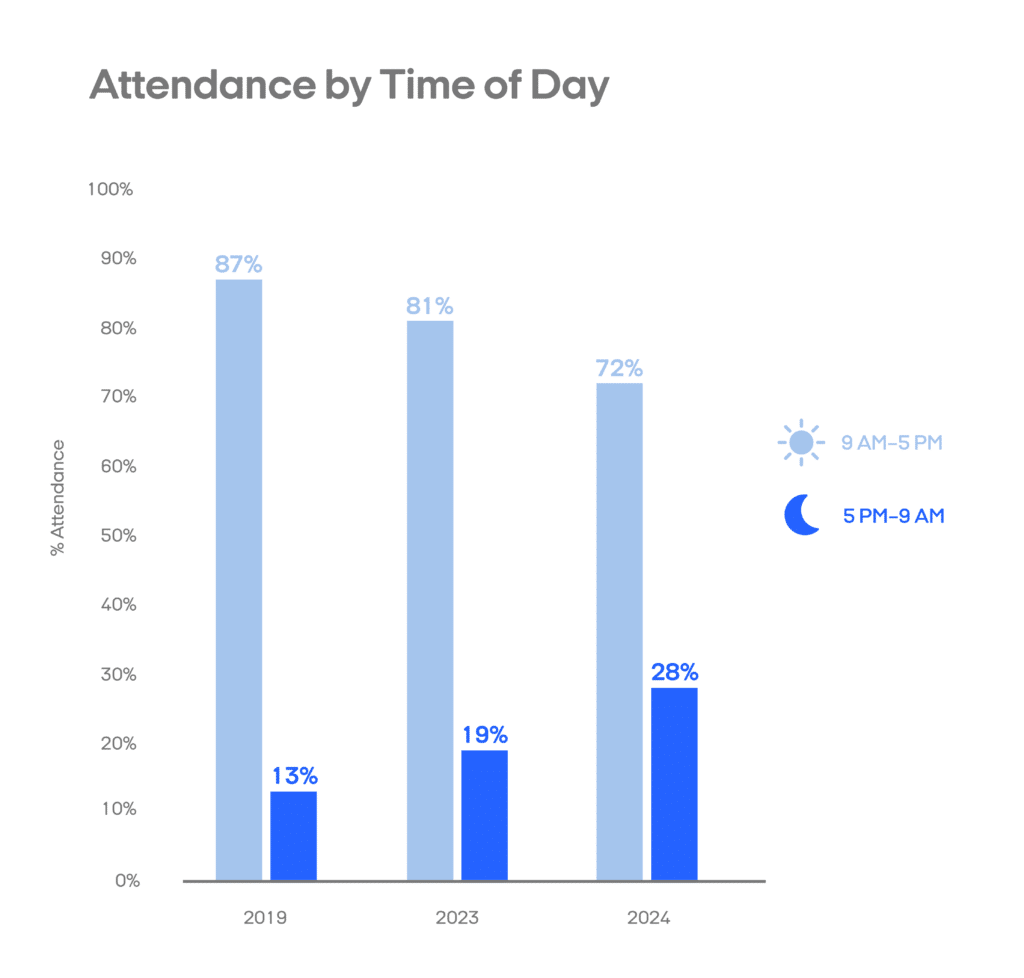
Bright and early. The shift toward earlier office attendance, evidenced by a 2.6 percentage point higher machine usage from 6 to 9 AM compared to 4 to 7 PM on an average day, reflects a blend of practicality, productivity, and cultural norms that have stuck with us even after the pandemic. Usage data also indicates that 8 to 9 AM is one of the most popular times to visit the Bevi machine before starting the day. In 2024, usage during this hour rose 50% when comparing that hour to 2019.
Many workers embrace the “rise and grind” mindset, leveraging the quiet, distraction-free early hours to maximize efficiency. Early starts often align with personal obligations, like commutes or family responsibilities, and are culturally linked to professionalism and ambition. It still looks good to be in first, so to speak.
For 2024, more than a quarter—28%—of work took place in the office outside of the traditional 9-to-5 hours. That’s a big jump from pre-pandemic times when just 13% took place outside of 9-to-5.
6. Fast facts
More folks are sticking around for the Friday before Memorial Day. Over the past few years, office attendance on the Friday before Memorial Day has steadily risen. Dispense data shows the gap in consumption compared to a typical May Friday is shrinking: a 16% drop in 2022, 14.2% in 2023, and just 9.5% in 2024. This shift hints at more companies encouraging in-office time or teams coming together before the long holiday weekend.
Celebration in Beantown. The week of Juneteenth and the Celtics championship win brought a noticeable dip in Boston office attendance. It’s not surprising that fans in the City of Champions opted to celebrate – and employers in other cities should expect that employees may take the opportunity to experience a potentially once-in-a-lifetime event like a sports championship in their city.
The heat is on. A heatwave during the week of June 17th led to a significant decrease in office attendance, as indicated by the lowest dispensing levels in June for Boston and New York City offices. Electrolyte consumption in NYC increased 28% year-over-year at the same time, however, suggesting that those who came in prioritized hydration during the extreme temperatures.
Fourth of July: A clear exodus from the office. July 4th week saw the largest drop in dispense data among summer holidays, with a 36.7% decrease compared to the previous week. This outpaced the drops seen during Memorial Day week (14.3%) and Juneteenth week (9.3%). With the holiday falling on a Thursday, the extended weekend likely contributed to the steep decline in office attendance.
Boost your energy. The weekend of July 20th was a busy one for tech workers dealing with a major security outage. Dispense data shows that beverages with caffeine added nearly doubled compared to prior weekends, up 88%.



